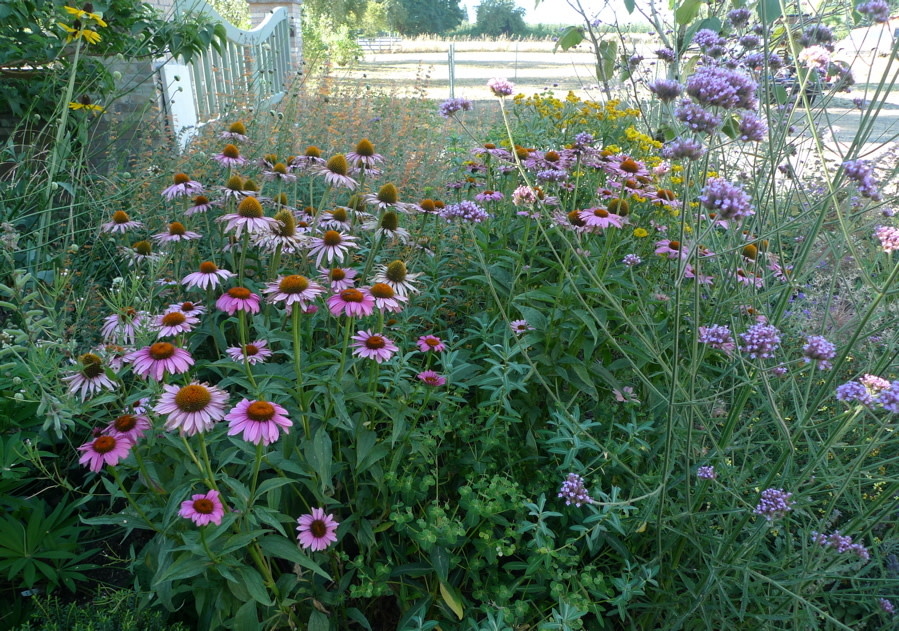Showy Late Summer Blooming Perennial Flowers

Most of us buy flowers for our gardens in spring, when we're desperate for color after the long, rainy winter. We grab the first things we see in flower on the benches! Peonies, irises, roses, columbines... lots of great, old fashioned flowers that are mostly done by the end of June/early July.
But what happens to the garden from mid-July onwards, when the spring-blooming plants are all done? Most people just give up. The ground's getting too hard to dig, or we're in and out on vacation, or we just run out of steam once the spring gardening projects are finished.
But by late summer, the weather's finally warm enough to sit outside. It almost never rains, the mornings and afternoons are still long and luxurious, and we can really sit down and enjoy the garden with a cup of tea in the morning or a cold drink in the evening. Now is when we can actually sit out and admire the flowers close-up and personal.
Plus, we can see the hummingbirds, butterflies and bees hard at work, collecting nectar and pollen... if we just sit down in the garden and look around us.
Here are 15 fantastic flowers that are in full bloom right now in our region and will provide a banquet for the birds, butterflies and the bees and a gorgeous, colorful garden for us to admire during the warmest, summeriest months of summer. You don't need acres to plant all this - just pick three or five that look nice together, and plant them right out by wherever you most often sit and enjoy a drink or a meal. Plant these perennials near where you sit in summer so you can really see them (and smell them, in some cases)... and enjoy how much the tiniest little pollinator-creatures enjoy them.
Yarrow (Achillea) 'Moonshine' My favorite yarrow, with big, flat heads of sunny yellow flowers that look great even as they fade to a tawny tan color. A lovely horizontal accent... attracts pollinators.
Giant hyssop (Agastache foeniculum) 'Golden Jubilee' and other cultivars - fat, purple-blue spikes of flowers in mid-summer and beyond - strong vertical accent. Attracts pollinators.
Anise hyssop (Agastache rupestris) All tubular-flowered hyssop draw hordes of hummers. Colors range from shades of orange to apricot, pink and purple - sometimes all on the same plant. This species produces an abundance of delicate apricot wands - very drought-, sun- and heat-tolerant plants with lusciously fragrant foliage. Requires good drainage. Attracts hummingbirds and pollinators galore.
Coneflower (Echinacea) 'Green Envy' and similar cultivars. Green Envy has prettiest pink flowers with green tips but it's hard to go wrong with Echinacea. Just know the doubles, while pretty, don't produce seed for birds or pollen for bees! Attracts pollinators.
Lady's eardrops (Fuchsia magellanica) 'Hawkshead' and other cultivars. Pick any cold-hardy fuchsia and it will be in bloom from late June to frost and can tolerate sun or shade, although best flowers are produced in sun. A fantastic hummingbird attractant.
Hop oregano (Origanum) 'Amethyst Falls' There are many kinds of hop oregano - all produce lovely, hop flower-like blossoms in July and then hold their neat bracts through frost. They are lovely spilling over walls and in containers. Great for pollinators.
Beard tongue (Penstemon kunthii) There are many penstemons; this particular one has the most delicious dark red flowers that blends well with other colors and is very easy to grow. Fabulous for attracting hummingbirds and pollinators.
Cape fuchsia (Phygelius) 'Passionale' Cape fuchsias are big, lusty plants that cover a lot of territory. They flower all summer if deadheaded, and are incredibly attractive to hummingbirds.
Black-eyed Susan (Rudbeckia fulgida) 'Goldsturm' A classic prairie flower that looks great with ornamental grasses and tall sedums. Great for pollinators.
Rudbeckia nitida 'Herbstonne' A truly striking, tall (to 7' high) perennial with the happiest, sunny yellow flowers with handsome "cones" that turn from green to yellow. Very attractive to pollinators.
Texas sage (Salvia x greggii) 'Flame' There are dozens of colors among the Texas sages (some cold-hardier than others) but all prorduce endless flowers from June to frost and beyond. Among the best for hummingbirds, pollinators.
Blue anise sage (Salvia guaranitica) 'Black & Blue' The flowers mix well with other flowers and appear non-stop from June or July to frost. Plants can be large - to 5' tall. Very attractive to hummingbirds and pollinators.
Stonecrop (Sedum) 'Autumn Joy' and other cultivars. There are many sedums - some with dark or variegated foliage, as well as the typical gray-green - and flower colors range from white to pink to dark red. All are tough, reliable and drought-tolerant. Wildly attractive to bees, pollinating insects.
Blue throatwort/Throatflower (Trachelium caeruleum) Rounded heads of blue or purple flowers (depending on the cultivar) on long-blooming plants. Needs good drainage! Attractive to pollinators.
California fuchsia (Zauschneria) 'Calistoga' Zauschneria are my favorite plants this year. Different types range from about 1 to 3 feet tall but all have bright orange (or sometimes pale pink or white) tubular flowers. They are drought-tolerant and can be either semi-evergreen or totally deciduous, depending on variety. Plants spread, so they are economical ground cover plants. Extremely attractive to hummingbirds.
There are many other great plants for hummingbirds including lobelias, Dicliptera , and much more. Other great pollinator-attracting perennials include tickseed (Coreopsis), Helenium, catmint (Nepeta), Eupatorium and more.
Tricks to buying the right plants for hummingbirds:
• Usually tubular flowers work
• Can be red but they don't have to be!
For more info on attracting hummers, read this.
Tricks to buying the right plants for pollinating insects including bees:
• Go to plant nursery and watch which plants the pollinators buzz around the most!
• Old-fashioned flowers are usually best - not latest new cultivars - richest in pollen because haven't been over-bred
• Single flowers usually best - not double-flowered forms, which often replace pollen in center with extra petals
For more info on attracting pollinating insects, read this.
